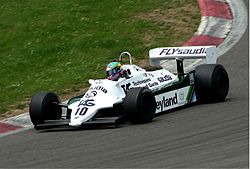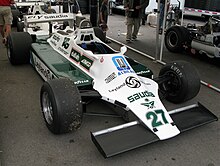
Formula One automobile racing has its roots in the European Grand Prix championships of the 1920s and 1930s, though the foundation of the modern Formula One began in 1946 with the Fédération Internationale de l'Automobile's (FIA) standardisation of rules, which was followed by a World Championship of Drivers in 1950.

The DFV is an internal combustion engine that was originally produced by Cosworth for Formula One motor racing. The name is an abbreviation of Double Four Valve, the engine being a V8 development of the earlier four-cylinder FVA, which had four valves per cylinder.

The 1979 British Grand Prix was a Formula One motor race held at Silverstone on 14 July 1979. It was the ninth race of the 1979 World Championship of F1 Drivers and the 1979 International Cup for F1 Constructors.

The 1980 Austrian Grand Prix was a Formula One motor race held on 17 August 1980 at the Österreichring circuit in Austria. It was the tenth race of the 1980 Formula One season. The race was the 13th Austrian Grand Prix and the eleventh to be held at the Österreichring. The race was held over 54 laps of the 5.942-kilometre circuit for a total race distance of 321 kilometres.
The 1980 Canadian Grand Prix was a Formula One motor race held on 28 September 1980, at the Circuit Île Notre-Dame in Montreal, Quebec, Canada. It was the thirteenth and penultimate race of the 1980 Formula One season. The race was the 19th Canadian Grand Prix and the third to be held in Montreal. The race was held over 70 laps of the 4.41-kilometre circuit for a total race distance of 309 kilometres.
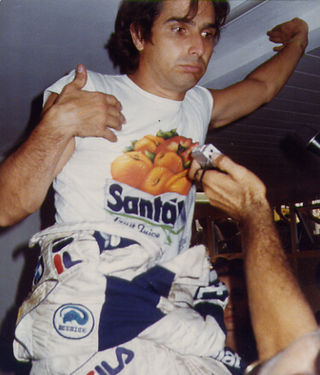
The 1981 FIA Formula One World Championship was the 35th season of FIA Formula One motor racing. It featured the 1981 Formula One World Championship for Drivers and the 1981 Formula One World Championship for Constructors, which were contested concurrently over a fifteen-race series that commenced on 15 March and ended on 17 October. Formula One cars also competed in the 1981 South African Grand Prix, although this was a Formula Libre race and was not part of the Formula One World Championship.

The 1980 Formula One season was the 34th season of FIA Formula One motor racing. It featured the 1980 World Championship of Drivers and the 1980 International Cup for F1 Constructors, which were contested concurrently from 13 January to 5 October over a fourteen-race series. The season also included one non-championship race, the Spanish Grand Prix.
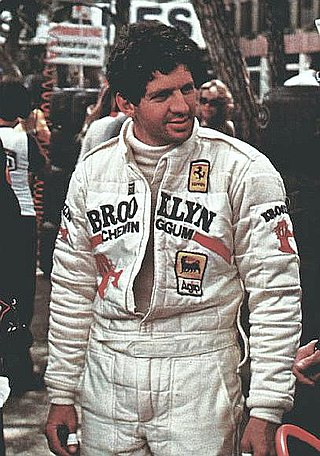
The 1979 Formula One season was the 33rd season of FIA Formula One motor racing. It featured the 1979 World Championship of F1 Drivers and the 1979 International Cup for F1 Constructors which were contested concurrently over a fifteen-round series which commenced on 21 January 1979, and ended on 7 October. The season also included three non-championship Formula One races. Jody Scheckter of Scuderia Ferrari won the 1979 World Championship of F1 Drivers while Scuderia Ferrari won 1979 International Cup for F1 Constructors. Gilles Villeneuve made it a 1–2 for Ferrari in the championship, concluding a successful second half of the 1970s for Ferrari. Alan Jones finished the season strongly for Williams, finishing third in the championship and with teammate Clay Regazzoni scoring Williams's first ever Grand Prix win as a constructor. Scheckter's title was Ferrari's last drivers' title for 21 years, before Michael Schumacher won five consecutive titles for the team between 2000 and 2004.
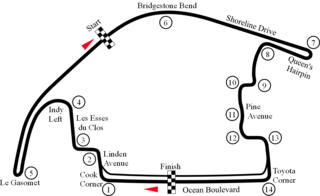
The 1981 United States Grand Prix West was a Formula One motor race held on March 15, 1981, at Long Beach, California. It was the opening race of the 1981 Formula One World Championship.
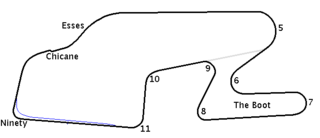
The 1980 United States Grand Prix was a Formula One motor race held on October 5, 1980 at the Watkins Glen Grand Prix Race Course in Watkins Glen, New York. This event was also referred to as the United States Grand Prix East in order to distinguish it from the United States Grand Prix West held on March 30, 1980 in Long Beach, California.

Team Lotus was the motorsport sister company of English sports car manufacturer Lotus Cars. The team ran cars in many motorsport categories including Formula One, Formula Two, Formula Ford, Formula Junior, IndyCar, and sports car racing. More than ten years after its last race, Team Lotus remained one of the most successful racing teams of all time, winning seven Formula One Constructors' titles, six Drivers' Championships, and the Indianapolis 500 in the United States between 1962 and 1978. Under the direction of founder and chief designer Colin Chapman, Lotus was responsible for many innovative and experimental developments in critical motorsport, in both technical and commercial arenas.

The Matra MS80 was the fourth Formula One car produced by Matra. The Ford Cosworth DFV-powered car took Jackie Stewart to the Formula One World Championship title in 1969.

The Lotus 79 is a Formula One car designed in late 1977 by Colin Chapman, Geoff Aldridge, Martin Ogilvie, Tony Rudd, Tony Southgate and Peter Wright of Lotus. The Lotus 79 was the first F1 car to take full advantage of ground effects aerodynamics.

The McLaren M23 was a Formula One racing car designed by Gordon Coppuck, with input from John Barnard, and built by the McLaren team. It was a development of the McLaren M16 Indianapolis 500 car. A Ford Cosworth DFV engine was used, which was prepared by specialist tuning company Nicholson-McLaren Engines. This helped push the DFV's horsepower output to around 490 bhp.

The Ferrari 312T was a Ferrari Formula One car design, based on the 312B3 from 1974. In various versions, it was used from 1975 until 1980. It was designed by Mauro Forghieri for the 1975 season, and was an uncomplicated and clean design that responded well to mechanical upgrades.

The Brabham BT49 is a Formula One racing car designed by South African Gordon Murray for the British Brabham team. The BT49 competed in the 1979 to 1982 Formula One World Championships and was used by Brazilian driver Nelson Piquet to win his first World Championship in 1981.
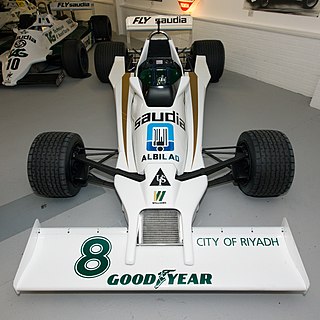
The Williams FW06 was the first car produced by the combination of Frank Williams and Patrick Head for their Williams Grand Prix Engineering Formula One team. As was the standard arrangement for the many small British garagiste teams, the car was powered by the Cosworth DFV 3.0 litre V8 engine.
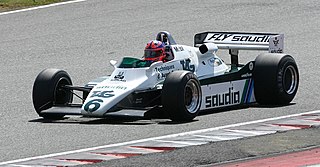
The Williams FW08 was a Formula One car designed by Frank Dernie, which debuted at the 1982 Belgian Grand Prix held at the Zolder circuit. An evolution of the FW07 that it replaced, the car was used by Finnish driver Keke Rosberg to win the 1982 World Drivers' Championship.

The Lola THL1 was a Formula One racing car designed by Neil Oatley for Team Haas (USA) Ltd. during four of the last five races of the 1985 Formula One season. The car used the 750 bhp, turbocharged Hart 415T Straight 4 engine. The Haas Lola team only had one car for 1985 and it was driven by 1980 World Champion Alan Jones, who was making a full-time comeback to Formula One at the age of 39.
